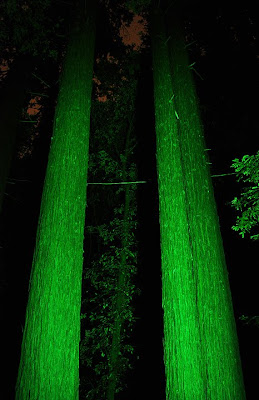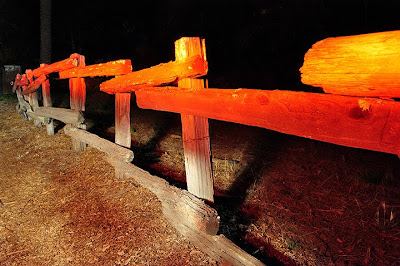 Visiting Key West, I had no idea how much I'd be fascinated by the look of this place. But each street, alley, and house somehow splashes with a glorious mélange of pastel and detritus. Soon I'll post a formal summary of our adventures in the Conch Republic, but today I'll meditate a bit about the funky vibe of this island.
Visiting Key West, I had no idea how much I'd be fascinated by the look of this place. But each street, alley, and house somehow splashes with a glorious mélange of pastel and detritus. Soon I'll post a formal summary of our adventures in the Conch Republic, but today I'll meditate a bit about the funky vibe of this island. Dripping with sweat, stupefied by sleepy abandon, Key West is a wreck of relics reclaimed and repackaged for tourist consumption. Here, ghost stories and castaways produce a shabby postcard history of rail barons, hanging moss, salvage ships, and joyful despair. Seedy and weedy, this place is designed for distribution by artist print and personal snapshot.
Dripping with sweat, stupefied by sleepy abandon, Key West is a wreck of relics reclaimed and repackaged for tourist consumption. Here, ghost stories and castaways produce a shabby postcard history of rail barons, hanging moss, salvage ships, and joyful despair. Seedy and weedy, this place is designed for distribution by artist print and personal snapshot. Even so, Key West is no theme park. Its houses, each a potentially wrecked Edmund Fitzgerald, are battened to suffer the real lash of hurricane and tidal surge. Each tin roof may evoke landlubber fantasies of Red Lobsters, of some conference-city blues bar festooned with Walmart holiday lights, but houses on this island make sense when dark clouds roil.
Even so, Key West is no theme park. Its houses, each a potentially wrecked Edmund Fitzgerald, are battened to suffer the real lash of hurricane and tidal surge. Each tin roof may evoke landlubber fantasies of Red Lobsters, of some conference-city blues bar festooned with Walmart holiday lights, but houses on this island make sense when dark clouds roil. Walking with friends, training my camera toward the clutter of tropical houses and overgrown gardens, I am drawn to the narrow spaces between art galleries and booze shacks, particularly those that stretch away from Duval Street. Dangling trees and spiky bushes pour over the sidewalks, shade for those who study visitors with the precision of bankers.
Walking with friends, training my camera toward the clutter of tropical houses and overgrown gardens, I am drawn to the narrow spaces between art galleries and booze shacks, particularly those that stretch away from Duval Street. Dangling trees and spiky bushes pour over the sidewalks, shade for those who study visitors with the precision of bankers. Bleary from the previous night's Patrón shots, I meet with Mari to wander the misty streets on a Sunday morning. We drift over the cracked sidewalks of an 1847 cemetery, waiting for the sun to peek through bulging black clouds. Roosters strut amid the headstones; nearby, houses are consumed by verdant ghosts.
Bleary from the previous night's Patrón shots, I meet with Mari to wander the misty streets on a Sunday morning. We drift over the cracked sidewalks of an 1847 cemetery, waiting for the sun to peek through bulging black clouds. Roosters strut amid the headstones; nearby, houses are consumed by verdant ghosts. The old cemetery is stacked with broken graves, some that appear to be freshly opened. How could someone live by, so close to this place? It's bad enough, I presume, that one must confront the eternal mysteries of the dead. Even worse here on this haunted island, one must also abide camera-toting tourists who search the stones in vain for Ernest Hemingway.
The old cemetery is stacked with broken graves, some that appear to be freshly opened. How could someone live by, so close to this place? It's bad enough, I presume, that one must confront the eternal mysteries of the dead. Even worse here on this haunted island, one must also abide camera-toting tourists who search the stones in vain for Ernest Hemingway. Back in the party section of town, near Mallory Square where revelers beat the drums for sunset, the afternoon light glows reddish-gold. The air is drunk, heavy, and thick; no ocean breezes today. The sun melts over the water and this city of humidors offers up a cigar, a smile, and a practiced snip for the vacationing revolutionary. The fan blades turn and nothing moves.
Back in the party section of town, near Mallory Square where revelers beat the drums for sunset, the afternoon light glows reddish-gold. The air is drunk, heavy, and thick; no ocean breezes today. The sun melts over the water and this city of humidors offers up a cigar, a smile, and a practiced snip for the vacationing revolutionary. The fan blades turn and nothing moves. My memories of Key West drain somehow to New Orleans, that cancerous commotion of wrought-iron railings and urine-stained walls, the whiff of elegant decay. Storms threaten both places; a terrible future waits over the waters, but that day is not this day. Instead, locals and tourists strip to their skivvies when rain begins, laughing.
My memories of Key West drain somehow to New Orleans, that cancerous commotion of wrought-iron railings and urine-stained walls, the whiff of elegant decay. Storms threaten both places; a terrible future waits over the waters, but that day is not this day. Instead, locals and tourists strip to their skivvies when rain begins, laughing.
(Photographs by Andrew Wood)








